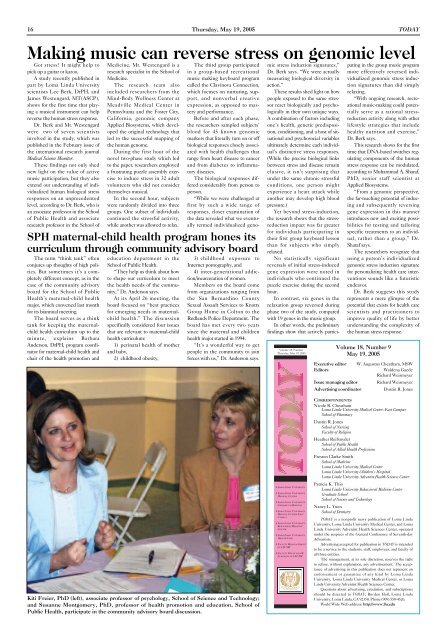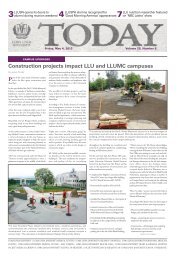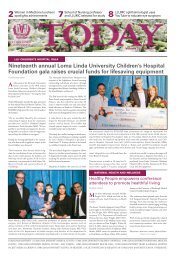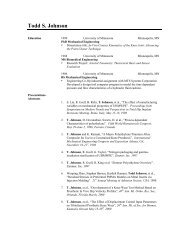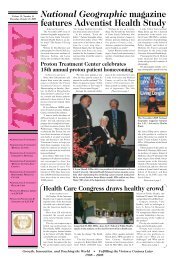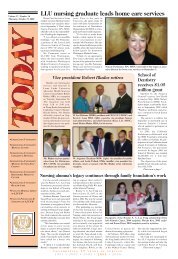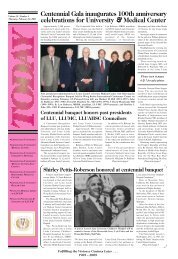Commencement services for medicine, dentistry planned for Sunday ...
Commencement services for medicine, dentistry planned for Sunday ...
Commencement services for medicine, dentistry planned for Sunday ...
Create successful ePaper yourself
Turn your PDF publications into a flip-book with our unique Google optimized e-Paper software.
16 Thursday, May 19, 2005<br />
TODAY<br />
Making music can reverse stress on genomic level<br />
Got stress? It might help to<br />
pick up a guitar or kazoo.<br />
A study recently published in<br />
part by Loma Linda University<br />
scientists Lee Berk, DrPH, and<br />
James Westengard, MT(ASCP),<br />
shows <strong>for</strong> the first time that playing<br />
a musical instrument can help<br />
reverse the human stress response.<br />
Dr. Berk and Mr. Westengard<br />
were two of seven scientists<br />
involved in the study, which was<br />
published in the February issue of<br />
the international research journal<br />
Medical Science Monitor.<br />
These findings not only shed<br />
new light on the value of active<br />
music participation, but they also<br />
extend our understanding of individualized<br />
human biological stress<br />
responses on an unprecedented<br />
level, according to Dr. Berk, who is<br />
an associate professor in the School<br />
of Public Health and associate<br />
research professor in the School of<br />
Medicine. Mr. Westengard is a<br />
research specialist in the School of<br />
Medicine.<br />
The research team also<br />
included researchers from the<br />
Mind-Body Wellness Center at<br />
Meadville Medical Center in<br />
Pennsylvania and the Foster City,<br />
Cali<strong>for</strong>nia, genomic company<br />
Applied Biosystems, which developed<br />
the original technology that<br />
led to the successful mapping of<br />
the human genome.<br />
During the first hour of the<br />
novel two-phase study which led<br />
to the paper, researchers employed<br />
a frustrating puzzle assembly exercise<br />
to induce stress in 32 adult<br />
volunteers who did not consider<br />
themselves musical.<br />
In the second hour, subjects<br />
were randomly divided into three<br />
groups. One subset of individuals<br />
continued the stressful activity,<br />
while another was allowed to relax.<br />
The third group participated<br />
in a group-based recreational<br />
music making keyboard program<br />
called the Clavinova Connection,<br />
which focuses on nurturing, support,<br />
and nonverbal creative<br />
expression, as opposed to mastery<br />
and per<strong>for</strong>mance.<br />
Be<strong>for</strong>e and after each phase,<br />
the researchers sampled subjects’<br />
blood <strong>for</strong> 45 known genomic<br />
markers that literally turn on or off<br />
biological responses closely associated<br />
with health challenges that<br />
range from heart disease to cancer<br />
and from diabetes to inflammatory<br />
diseases.<br />
The biological responses differed<br />
considerably from person to<br />
person.<br />
“While we were challenged at<br />
first by such a wide range of<br />
responses, closer examination of<br />
the data revealed what we eventually<br />
termed individualized geno-<br />
SPH maternal-child health program hones its<br />
curriculum through community advisory board<br />
The term “think tank” often<br />
conjures up thoughts of high politics.<br />
But sometimes it’s a completely<br />
different concept, as in the<br />
case of the community advisory<br />
board <strong>for</strong> the School of Public<br />
Health’s maternal-child health<br />
major, which convened last month<br />
<strong>for</strong> its biannual meeting.<br />
The board serves as a think<br />
tank <strong>for</strong> keeping the maternalchild<br />
health curriculum up to the<br />
minute, explains Barbara<br />
Anderson, DrPH, program coordinator<br />
<strong>for</strong> maternal-child health and<br />
chair of the health promotion and<br />
education department in the<br />
School of Public Health.<br />
“They help us think about how<br />
to shape our curriculum to meet<br />
the health needs of the community,”<br />
Dr. Anderson says.<br />
At its April 26 meeting, the<br />
board focused on “best practices<br />
<strong>for</strong> emerging needs in maternalchild<br />
health.” The discussion<br />
specifically considered four issues<br />
that are relevant to maternal-child<br />
health curriculum:<br />
1) perinatal health of mother<br />
and baby,<br />
2) childhood obesity,<br />
3) childhood exposure to<br />
Internet pornography, and<br />
4) inter-generational addiction/incarceration<br />
of women.<br />
Members on the board come<br />
from organizations ranging from<br />
the San Bernardino County<br />
Sexual Assault Services to Knotts<br />
Group Home in Colton to the<br />
Redlands Police Department. The<br />
board has met every two years<br />
since the maternal and children<br />
health major started in 1994.<br />
“It’s a wonderful way to get<br />
people in the community to join<br />
<strong>for</strong>ces with us,” Dr. Anderson says.<br />
Kiti Freier, PhD (left), associate professor of psychology, School of Science and Technology;<br />
and Susanne Montgomery, PhD, professor of health promotion and education, School of<br />
Public Health, participate in the community advisory board discussion.<br />
mic stress induction signatures,”<br />
Dr. Berk says. “We were actually<br />
measuring biological diversity in<br />
action.”<br />
These results shed light on how<br />
people exposed to the same stressor<br />
react biologically and psychologically<br />
in their own unique ways.<br />
A combination of factors including<br />
one’s health, genetic predisposition,<br />
conditioning, and a host of situational<br />
and psychosocial variables<br />
ultimately determine each individual’s<br />
distinctive stress responses.<br />
(While the precise biological links<br />
between stress and disease remain<br />
elusive, it isn’t surprising that<br />
under the same chronic stressful<br />
conditions, one person might<br />
experience a heart attack while<br />
another may develop high blood<br />
pressure.)<br />
Yet beyond stress-induction,<br />
the research shows that the stressreduction<br />
impact was far greater<br />
<strong>for</strong> individuals participating in<br />
their first group keyboard lesson<br />
than <strong>for</strong> subjects who simply<br />
relaxed.<br />
No statistically significant<br />
reversals of initial stress-induced<br />
gene expression were noted in<br />
individuals who continued the<br />
puzzle exercise during the second<br />
hour.<br />
In contrast, six genes in the<br />
relaxation group reversed during<br />
phase two of the study, compared<br />
with 19 genes in the music group.<br />
In other words, the preliminary<br />
findings show that actively partici-<br />
Volume Volume 18, Number 18, Number 4<br />
Thursday, February May 19, 24, 2005 2005<br />
• LOMA LINDA UNIVERSITY<br />
• LOMA LINDA UNIVERSITY<br />
MEDICAL CENTER<br />
• LOMA LINDA UNIVERSITY<br />
CHILDREN’S HOSPITAL<br />
• LOMA LINDA UNIVERSITY<br />
MEDICAL CENTER–EAST<br />
CAMPUS<br />
• LOMA LINDA UNIVERSITY<br />
BEHAVIORAL MEDICINE<br />
CENTER<br />
• LOMA LINDA UNIVERSITY<br />
HEALTH CARE<br />
• FACULTY MEDICAL GROUP<br />
OF LLUSM<br />
• FACULTY PHYSICIANS &<br />
SURGEONS OF LLUSM<br />
T O M A K E M A N W H O L E<br />
Volume 18, Number 9<br />
May 19, 2005<br />
Executive editor W. Augustus Cheatham, MSW<br />
Editors Waldena Gaede<br />
Richard Weismeyer<br />
Issue managing editor Richard Weismeyer<br />
Advertising coordinator Dustin R. Jones<br />
CORRESPONDENTS<br />
Nicole R. Cheatham<br />
Loma Linda University Medical Center–East Campus<br />
School of Pharmacy<br />
Dustin R. Jones<br />
School of Nursing<br />
Faculty of Religion<br />
Heather Reifsnyder<br />
School of Public Health<br />
School of Allied Health Professions<br />
Preston Clarke Smith<br />
School of Medicine<br />
Loma Linda University Medical Center<br />
Loma Linda University Children’s Hospital<br />
Loma Linda University Adventist Health Sciences Center<br />
Patricia K. Thio<br />
Loma Linda University Behavioral Medicine Center<br />
Graduate School<br />
School of Science and Technology<br />
Nancy L. Yuen<br />
School of Dentistry<br />
pating in the group music program<br />
more effectively reversed individualized<br />
genomic stress induction<br />
signatures than did simply<br />
relaxing.<br />
“With ongoing research, recreational<br />
music-making could potentially<br />
serve as a rational stressreduction<br />
activity along with other<br />
lifestyle strategies that include<br />
healthy nutrition and exercise,”<br />
Dr. Berk says.<br />
This research shows <strong>for</strong> the first<br />
time that DNA-based switches regulating<br />
components of the human<br />
stress response can be modulated,<br />
according to Muhammad A. Sharaf,<br />
PhD, senior staff scientist at<br />
Applied Biosystems.<br />
“From a genomic perspective,<br />
the far-reaching potential of inducing<br />
and subsequently reversing<br />
gene expression in this manner<br />
introduces new and exciting possibilities<br />
<strong>for</strong> testing and tailoring<br />
specific treatments to an individual,<br />
rather than a group,” Dr.<br />
Sharaf says.<br />
The researchers recognize that<br />
using a person’s individualized<br />
genomic stress induction signature<br />
<strong>for</strong> personalizing health care interventions<br />
sounds like a futuristic<br />
endeavor.<br />
Dr. Berk suggests this study<br />
represents a mere glimpse of the<br />
potential that exists <strong>for</strong> health care<br />
scientists and practitioners to<br />
improve quality of life by better<br />
understanding the complexity of<br />
the human stress response.<br />
TODAY is a nonprofit news publication of Loma Linda<br />
University, Loma Linda University Medical Center, and Loma<br />
Linda University Adventist Health Sciences Center, operated<br />
under the auspices of the General Conference of Seventh-day<br />
Adventists.<br />
Advertising accepted <strong>for</strong> publication in TODAY is intended<br />
to be a service to the students, staff, employees, and faculty of<br />
all three entities.<br />
The management, at its sole discretion, reserves the right<br />
to refuse, without explanation, any advertisement. The acceptance<br />
of advertising in this publication does not represent an<br />
endorsement or guarantee of any kind by Loma Linda<br />
University, Loma Linda University Medical Center, or Loma<br />
Linda University Adventist Health Sciences Center.<br />
Questions about advertising, circulation, and subscriptions<br />
should be directed to TODAY, Burden Hall, Loma Linda<br />
University, Loma Linda, CA 92350. Phone (909) 558-4526.<br />
World Wide Web address: http://www.llu.edu<br />
Fulfilling the Vision a Century Later . . .<br />
1905 – 2005


